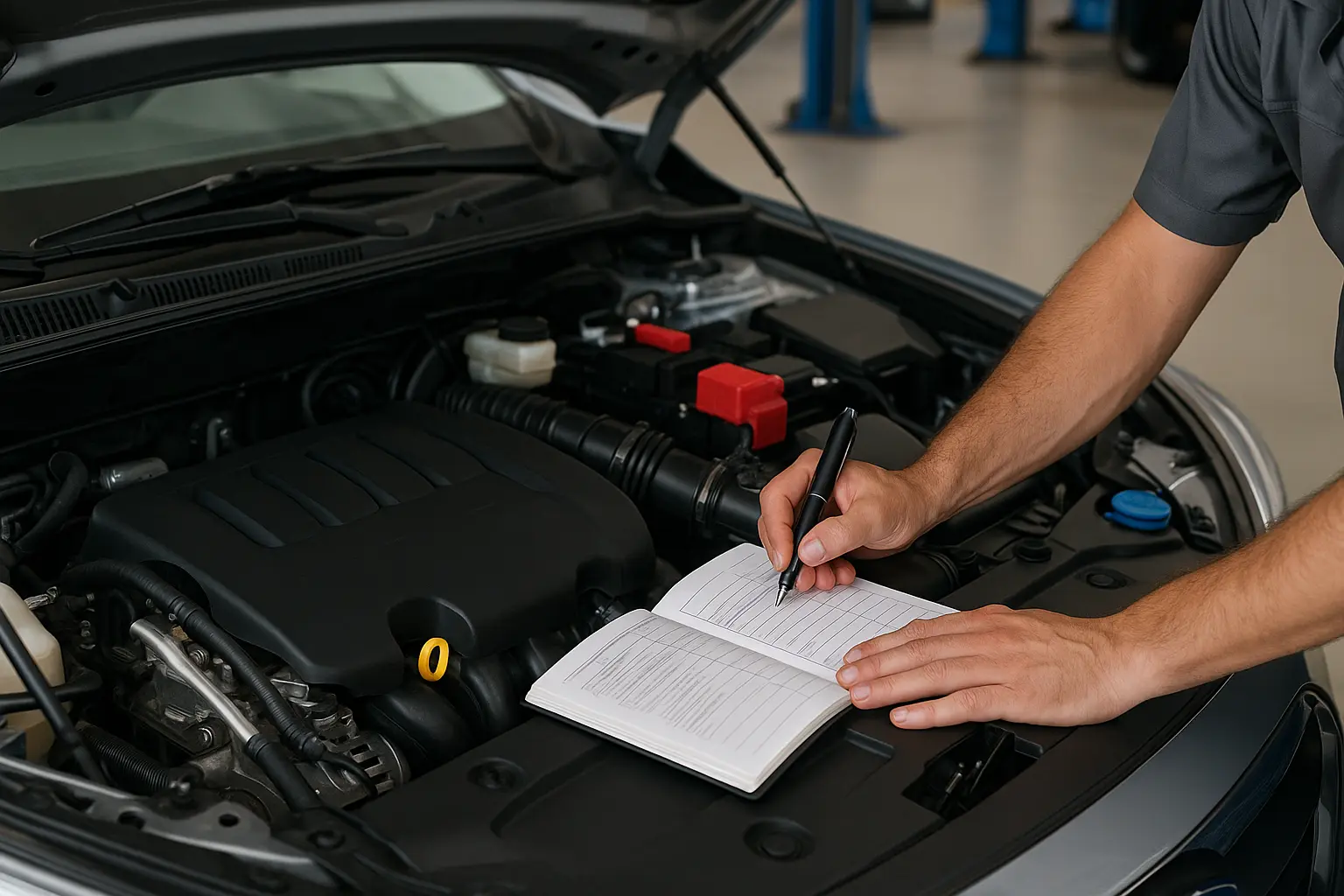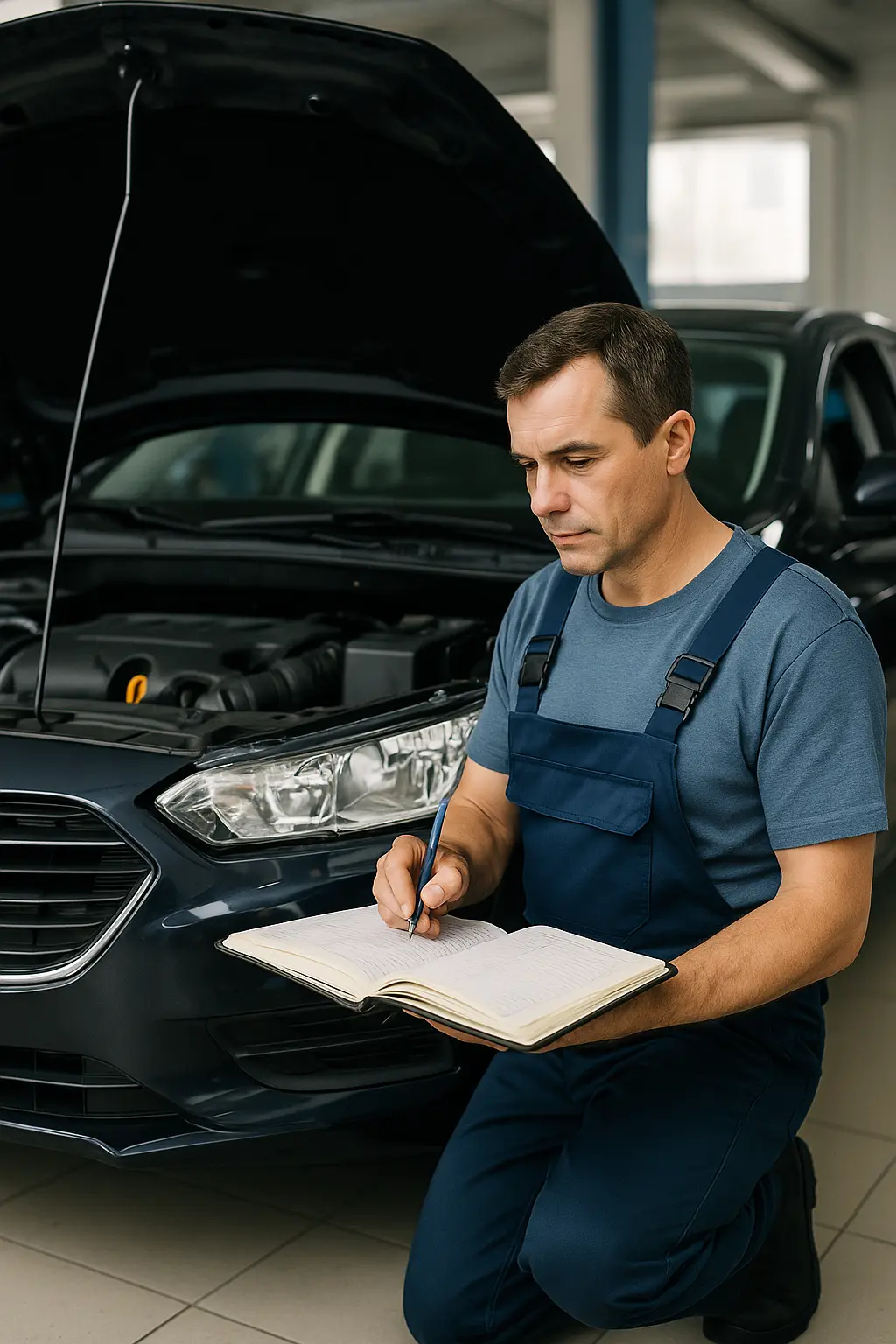🚗 What Is a Logbook Service?
A logbook service is a manufacturer-specified routine maintenance carried out at predefined intervals—typically based on time (every 6 or 12 months) or kilometres driven (every 10,000 to 15,000 km). It includes inspections, part replacements, and checks that align with the vehicle’s warranty conditions and performance standards.
Unlike general servicing, a logbook service must strictly follow the specifications outlined in your vehicle’s service manual (a.k.a. logbook). These are designed to keep the car in optimal condition and preserve warranty coverage.
Key Elements of a Logbook Service:
Engine oil and filter change
Brake system check and adjustment
Suspension and steering inspection
Battery test and condition
Tyre rotation and pressure check
Fluid top-ups (coolant, brake, transmission, washer)
Diagnostic scan (if needed)

🧾 Why Is It Called a “Logbook” Service?
The term "logbook" refers to the vehicle service record book that comes with every new car. It’s where certified mechanics stamp and sign off on each completed service. This logbook serves as an official history of the car's upkeep and plays a critical role in validating warranty claims and boosting resale value.
🛠️ Who Can Perform a Logbook Service?
Contrary to common belief, you don’t always have to go to a dealership. As long as the service is performed by a licensed mechanic using parts that meet OEM (Original Equipment Manufacturer) standards—and follows the logbook schedule—your warranty remains valid.
Options for Service:
Authorised Dealerships
Pros: Warranty familiarity, OEM parts, experienced in brand-specific issues.
Cons: Expensive, long waiting times.Independent Licensed Mechanics
Pros: Cost-effective, personalised service.
Cons: Need to confirm they use OEM-equivalent parts and follow the logbook exactly.
🔍 How a Logbook Service Affects Resale Value
In the competitive used car market in Australia, having a fully stamped and up-to-date logbook can significantly increase your car’s resale appeal and final price.
Why Buyers Care:
Proof of Proper Maintenance: Buyers feel confident knowing the vehicle has been cared for correctly.
Warranty Continuity: If the vehicle is still under warranty, the buyer may benefit from it if the logbook is complete.
Avoids Future Repair Surprises: Buyers often avoid cars without service histories due to fear of hidden mechanical issues.
💡 A well-maintained logbook can increase your resale value by $1,000–$3,000 depending on the model and condition.
💡 Logbook vs. General Service – What’s the Difference?
| Feature | Logbook Service | General/Basic Service |
|---|---|---|
| Follows manufacturer specs | ✅ Yes | ❌ Not necessarily |
| Required to maintain warranty | ✅ Yes | ❌ No |
| Includes record stamp | ✅ Yes | ❌ Optional or not provided |
| Cost | 💰 Medium to High | 💰 Lower |
📅 When Should You Get a Logbook Service?
Your vehicle's manual will specify time and distance intervals. The general rule of thumb in Australia:
Every 10,000–15,000 km
Or every 6–12 months, whichever comes first.
🔧 Skipping a scheduled service can risk voiding your warranty.
🚫 Common Mistakes That Devalue Your Car
Missing Services: Gaps in the logbook raise red flags for buyers.
Incorrect Service Providers: Using a non-certified mechanic who doesn’t follow the logbook can void your warranty.
Using Non-OEM Parts: Could affect car performance and resale perception.
No Documentation: Always get a copy of the invoice and service stamp.
💰 Logbook Services and Car Finance
Many finance providers and lease agreements in Australia require logbook servicing to maintain coverage or residual value guarantees.
Why It Matters:
Novated leases: Employers may only cover costs if services are logbook compliant.
Loan resale evaluations: Cars with complete service histories often appraise higher during final repayments.
🧾 What Should Be Included in the Invoice?
Every time you go in for a logbook service, make sure your invoice includes:
Date of service
Odometer reading
List of all tasks performed
Fluids topped up or replaced
Parts used (with OEM or equivalent stated)
Mechanic's license number
Official stamp in the logbook
✅ Is It Worth the Cost?
While logbook services may cost more than a basic service, the long-term value is clear:
Maintains car performance
Keeps warranty valid
Prevents expensive repairs later
Increases resale value
Builds buyer confidence
⚠️ What Happens If You Skip Logbook Services?
Warranty Voided: Most manufacturers require proof of scheduled maintenance.
Accelerated Wear & Tear: Especially critical for newer vehicles with complex electronics.
Lower Resale Value: Buyers will question mechanical condition.
Finance Penalties: Leased vehicles may incur exit penalties or extra charges.
🔎 Buyer Tip: Always Ask for the Logbook!
When buying a used car in Australia, always ask for the physical logbook or a verified digital record. Red flags include:
Pages missing or torn
Gaps in service intervals
Generic workshop stamps
Lack of itemised service history
🧰 What About Digital Logbooks?
Some brands now offer digital servicing records linked to your car’s VIN, stored in online portals.
Pros:
No risk of lost paperwork
Instant access from any device
Harder to forge or fake
Cons:
May not be transferable across all resale platforms
Not all workshops participate
🏁 Final Checklist: How to Maximise Resale Value With Logbook Servicing
✅ Always service on time (km or months)
✅ Use OEM parts or equivalents
✅ Choose a licensed mechanic
✅ Keep every invoice and logbook stamp
✅ Avoid missing any scheduled checks
✅ Clean, store, and preserve your logbook safely
🔚 Conclusion
A logbook service isn't just routine maintenance—it’s an investment in your car’s health and value. Whether you're driving a brand-new hybrid SUV, a diesel ute, or a budget-friendly hatchback, keeping up with scheduled logbook servicing is one of the smartest moves you can make as an Aussie car owner.
It keeps your vehicle running smoothly, protects your warranty, and helps you secure top dollar when it’s time to sell.
Leave a comment
Your email address will not be published. Required fields are marked *




